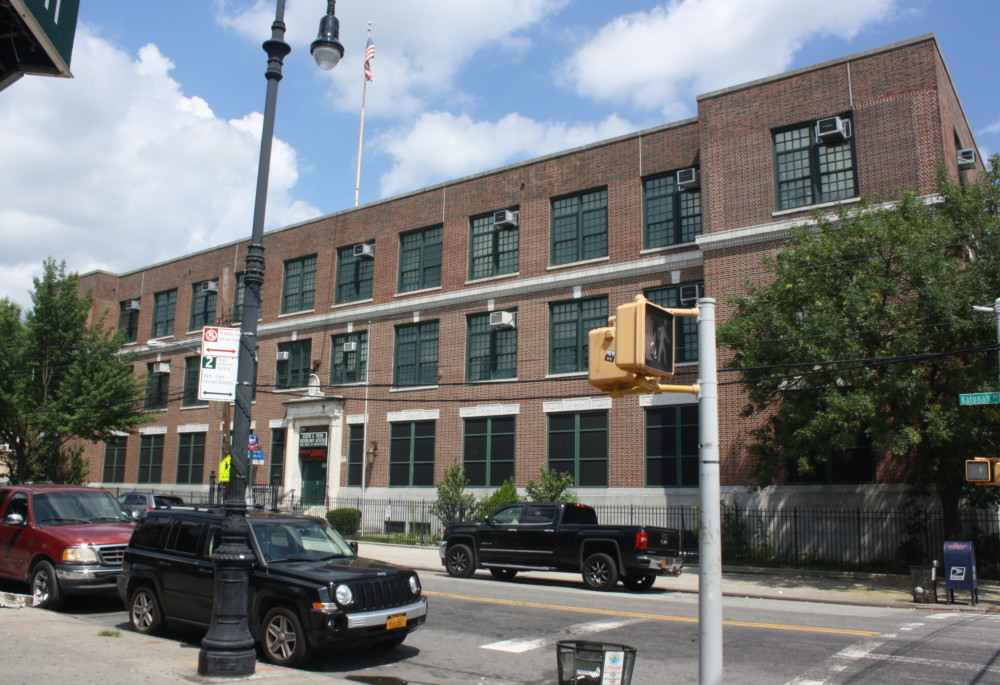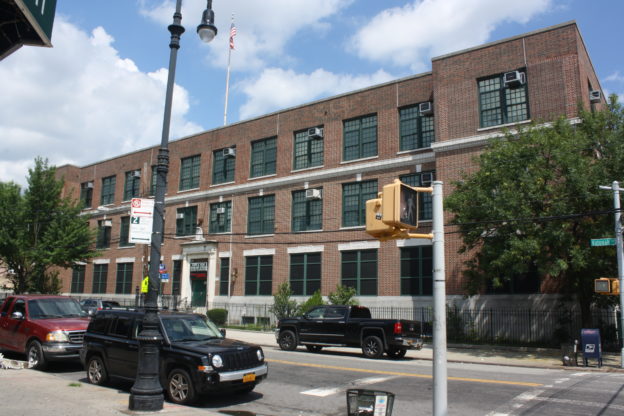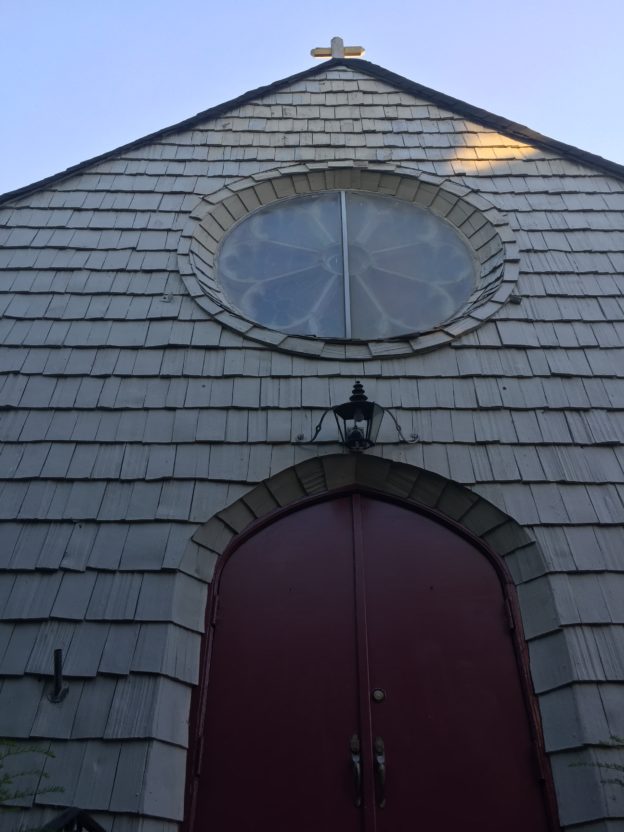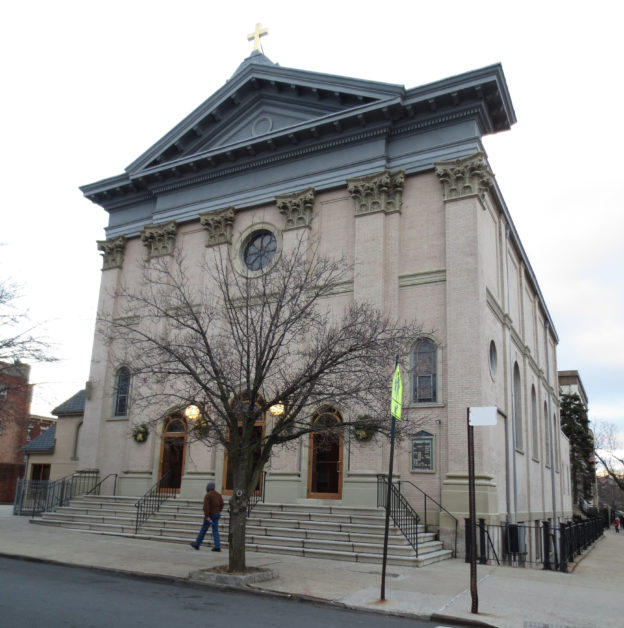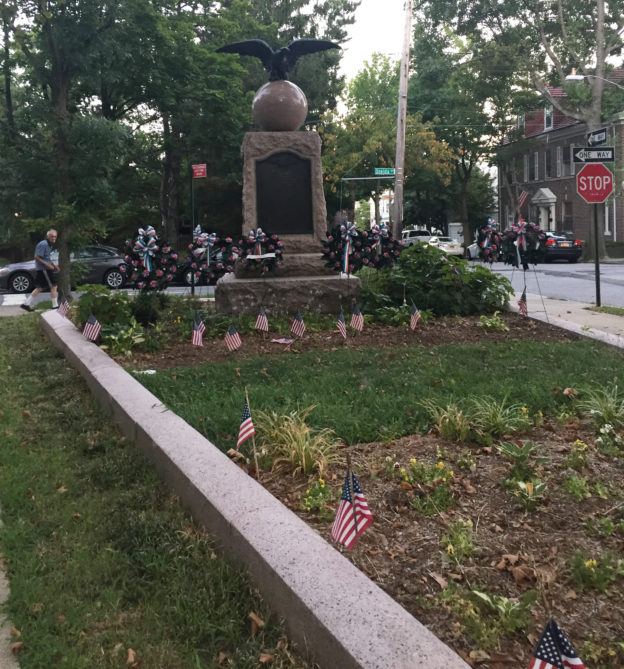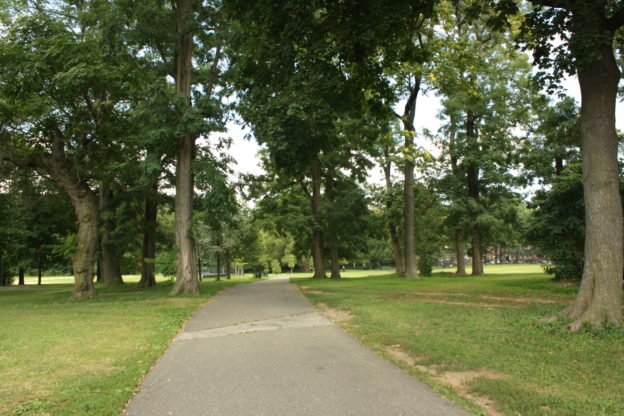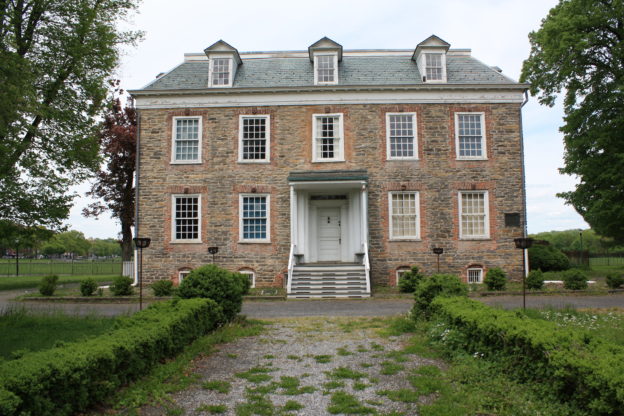4318 Katonah Avenue
1924
Woodlawn Heights’ local Public School 19, serving students from kindergarten through eighth grade, spans Katonah Avenue between East 237th and East 238th Streets. The imposing brick structure features Classically-inspired details, including a monumental entrance with engaged columns topped with an ornamental shield, window lintels with urn and garland motifs, and a dentilled cornice above the second story. Perhaps the most prominent feature on the building is its multi-light windows with green frames, which appear to be relatively new. The green color scheme is quite striking, and may have been chosen to reflect and honor Woodlawn Heights’ Irish-American and Irish heritage.
439 East 238th Street
1901
Originally established as the “Chapel of Advent” in 1897, this small parish’s first services were held in a rented storefront chapel on Webster Avenue and East 234th Street. Renamed in honor of its first vicar, Reverend Stephen Van Rensselaer, St. Stephen’s Episcopal Church purchased its present site in 1899 and the cornerstone was laid the following year. The white clapboard building resembles a countryside church, set back from Vireo Avenue by a green lawn with mature trees. Reportedly, a botanist from the New York Botanical Garden discovered a new species of English Ivy on the grounds of the church in 1981, and named it “238th Street” Ivy or “Hedera helix 238th Street.” Inside the church, there is a marble altar and a three-paneled painting by the Reverend John Walsted, an Episcopal priest and accomplished iconographer whose works also hang in the Church of the Transfiguration and the Cathedral of St. John the Divine. The rectory, which was remodeled in 1947, is adjacent to a Victorian style parish house, where the church operates a thrift shop.
4371 Martha Avenue
1914
In the spring of 1911, a group of Presbyterian residents of the neighborhood began holding services in private homes. The first official services open to the public were held in Hopewell Hall on East 240th Street in May of that year, presided over by Reverend Stevenson. In January 1913, the church was formally organized by the Presbytery of New York and a lot was purchased that year on the northwest corner of East 240th Street and Martha Avenue. The cornerstone was laid on September 28, 1913, and on May 10, 1914, the church was dedicated and the keys were presented to the first Pastor, Reverend W. F. Daun. The design of Woodlawn Heights Presbyterian was influenced by the Gothic Revival style, and features two large, ornate stained glass windows, one on the main façade facing Martha Avenue and the other on the side façade facing East 240th Street. Above the bright red double-door entrance are a crenelated parapet and a modest bell steeple. Unfortunately, the bell was subsequently removed and the steeple filled in with stucco.
409 East 241st Street
Starrett & Van Vleck
1911
Established and dedicated on the day of the feast of St. Barnabas in 1910 by Archbishop John Farley, this Catholic parish flourished from its approximately 360 original members to a congregation boasting almost 15,000. Its founder and pastor Reverend Michael A. Reilly fostered the church from its beginnings as a small storefront mission at the intersection of Webster Avenue and East 240th Street to the completion of this grand, Italianate style church and rectory. Over the next 15 years, the church also established an elementary school, high school and rectory, and later, a new high school building and a chapel. The architects of the church were Starrett & Van Vleck, a firm famous for its Art Deco department store buildings and whose portfolio includes several iconic landmarks, such as Saks Fifth Avenue, the American Stock Exchange Building, the Everett Building at Union Square North and Garfinckel’s Department Store in Washington, DC. St. Barnabas Church is monumental in scale and features a triangular pediment, circular rose window and massive Corinthian pilasters. Its cream-colored brick façades are punctuated by stained glass windows.
4390 Katonah Avenue
1913
The Trinity Community Church has an imposing presence facing Katonah Avenue. Its exterior, evoking a quaint country church, is clad in fieldstone and features a deeply crenellated parapet at its tower. The structure was built for the Methodist Episcopal Church of Woodlawn Heights, which later became St. Luke’s United Methodist Church. Established in 1875, the congregation’s first church was located on East 237th Street between Katonah and Kepler Avenues, on land donated by Edwin K. Willard. The parish commissioned this structure, completed in 1913, but eventually outgrew it, moving four blocks north to another site. The historic bell perched on the church’s front steps is older than the church, as evidenced by its inscription: “Clinton H. Meneely Bell Company, Troy, N.Y. A.D. 1892.”
Katonah Avenue and East 242nd Street
2000
This memorial is dedicated to the 23 men who lost their lives between 1970 and 2000 during construction of City Water Tunnel No. 3, a massive project that is still being built in stages. Tunnels No. 1 and No. 2 were completed in 1917 and 1936, respectively, to bring fresh water to the city from upstate New York. The construction of Tunnel No. 3 is a long-term endeavor to enhance and improve the water delivery system to the five boroughs. The Manhattan and Bronx legs of the tunnel have already been completed, while the Brooklyn and Queens legs, which will also supply water to Staten Island, have been completed but await activation (expected in 2020). The Department of Environmental Protection and the Local 147 sandhog union worked together to build this memorial, which consists of 23 manhole covers embedded in the pavement, a drinking fountain, trees, plants and a flag pole whose base is made of gray stones from the tunnel. Each manhole cover is engraved with the name of the person and the year of his death. The memorial’s location was selected due to its proximity to the underground chamber that directs flows from upstate water supply systems to all of the boroughs.
Broadway and Mosholu Avenue or Van Cortlandt Park East & Oneida Avenue
1997
The John Muir Trail is a 1.5-mile trek that passes through the Northeast Forest, the Croton Wood, the old Croton Aqueduct and the Northwest Forest. It is the only trail in Van Cortlandt Park that runs east-west, from Van Cortlandt Park East to Broadway, connecting Woodlawn Heights to Riverdale. The trail, established in 1997, was named for Scottish-American naturalist, author, early advocate for wilderness conservation in the United States and founder of the Sierra Club, John Muir (1838-1914).
Rita Ley Triangle/Oneida Triangle
East 238th Street and Oneida Avenue
dedicated in 1925
This 13-foot stone monument, topped with a sphere and an eagle sculpture, honors the residents of Woodlawn Heights who served and sacrificed their lives in World War I. The Oneida Triangle is an appropriate place for a war memorial given that it was the site of a small battle during the Revolutionary War, when Oneida Avenue was known as DeVoe’s Lane (it became Oneida Avenue in 1896). Oneida was also the name of a Civil War ship (USS Oneida) built at the New York Navy Yard in 1861 and commissioned in 1862. The Triangle, which was provided by the New York City Departments of Parks and Transportation for use as a memorial site, is also occupied by Norway and Sycamore maples, London plane trees and shrubs.
East 233rd Street between Jerome Avenue and Van Cortlandt Park East
Indian Field is dedicated to Chief Daniel Nimham, the last sachem of the Wappinger people, who, along with a number of other Wappinger that included his son, Captain Abraham Nimham, was ambushed by the British near this spot in 1778. The battle was fought on land owned by the DeVoe family, who were responsible for the burial and placement of a stone cairn on the Chief’s grave. In 1906, the Bronx Chapter for the Daughters of the American Revolution also honored their sacrifice with a stone cairn and plaque, known today as the Chief Nimham Memorial, which is located at Van Cortlandt Park East and East 238th Street.
enter at Broadway and West 246th Street
1748
NHL, NR-P, NYC IL, NYC INL
This fieldstone and brick Georgian style manor is The Bronx’s oldest house, built for Jacobus Van Cortlandt’s son, Frederick. Unfortunately, he died before it was completed and was the first to be buried in the family burial plot on Vault Hill, north of the house. Frederick left the estate to his son, James Van Cortlandt. Most notably, George Washington used the house for military maneuvers and as a temporary headquarters before his triumphant march into Manhattan during the Revolutionary War. The mansion has operated as a house museum—the first in the city—since 1897, when the National Society of Colonial Dames in the State of New York was granted custody to manage the site and exhibit its collection of 18th- and 19th-century furniture and decorative arts. The grounds also include a 1902 bronze statue of Major General Josiah Porter by William Clark Noble. The Van Cortlandt Mansion is a National Historic Landmark, NYC Individual Landmark and a NYC Interior Landmark.
